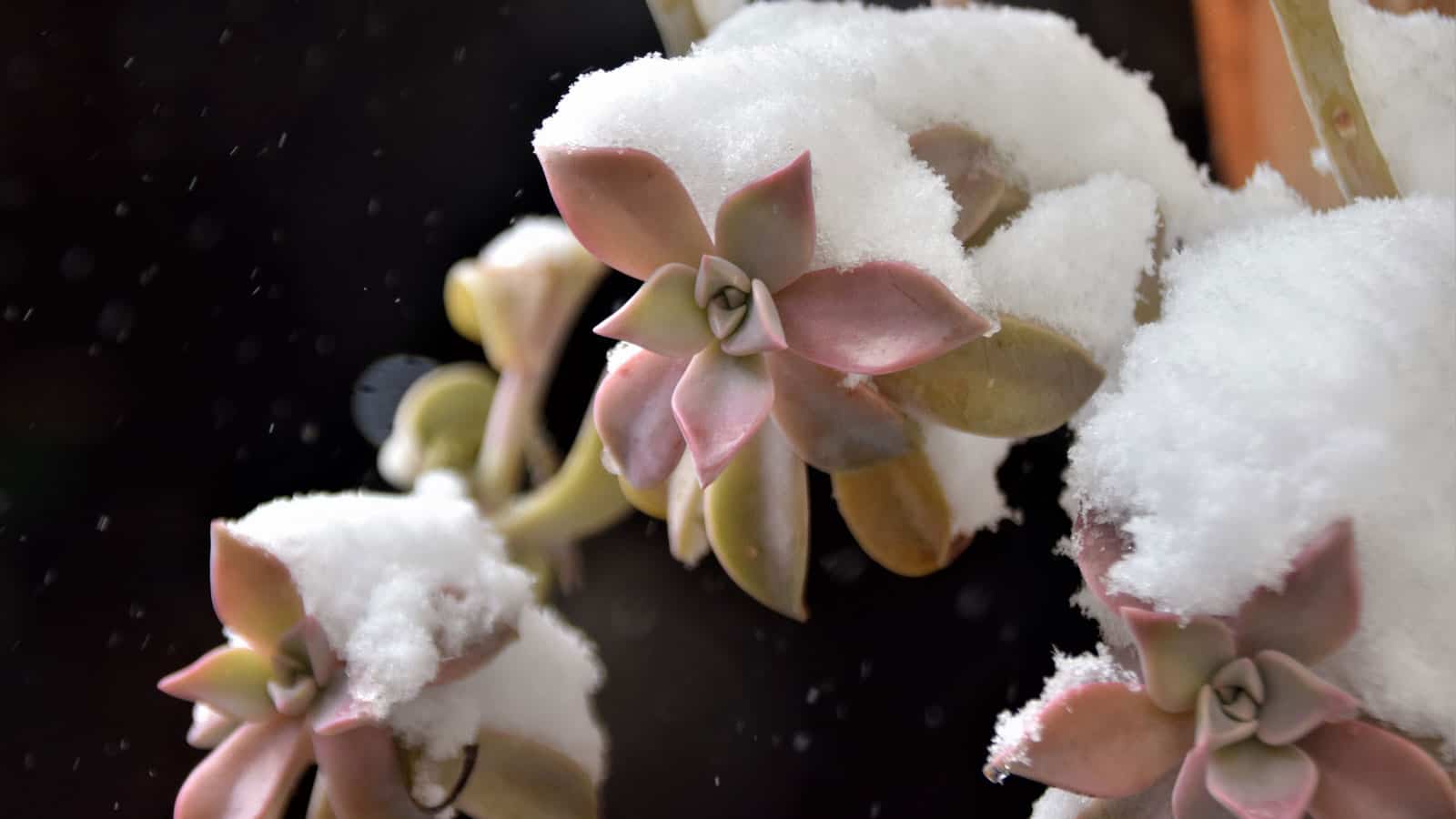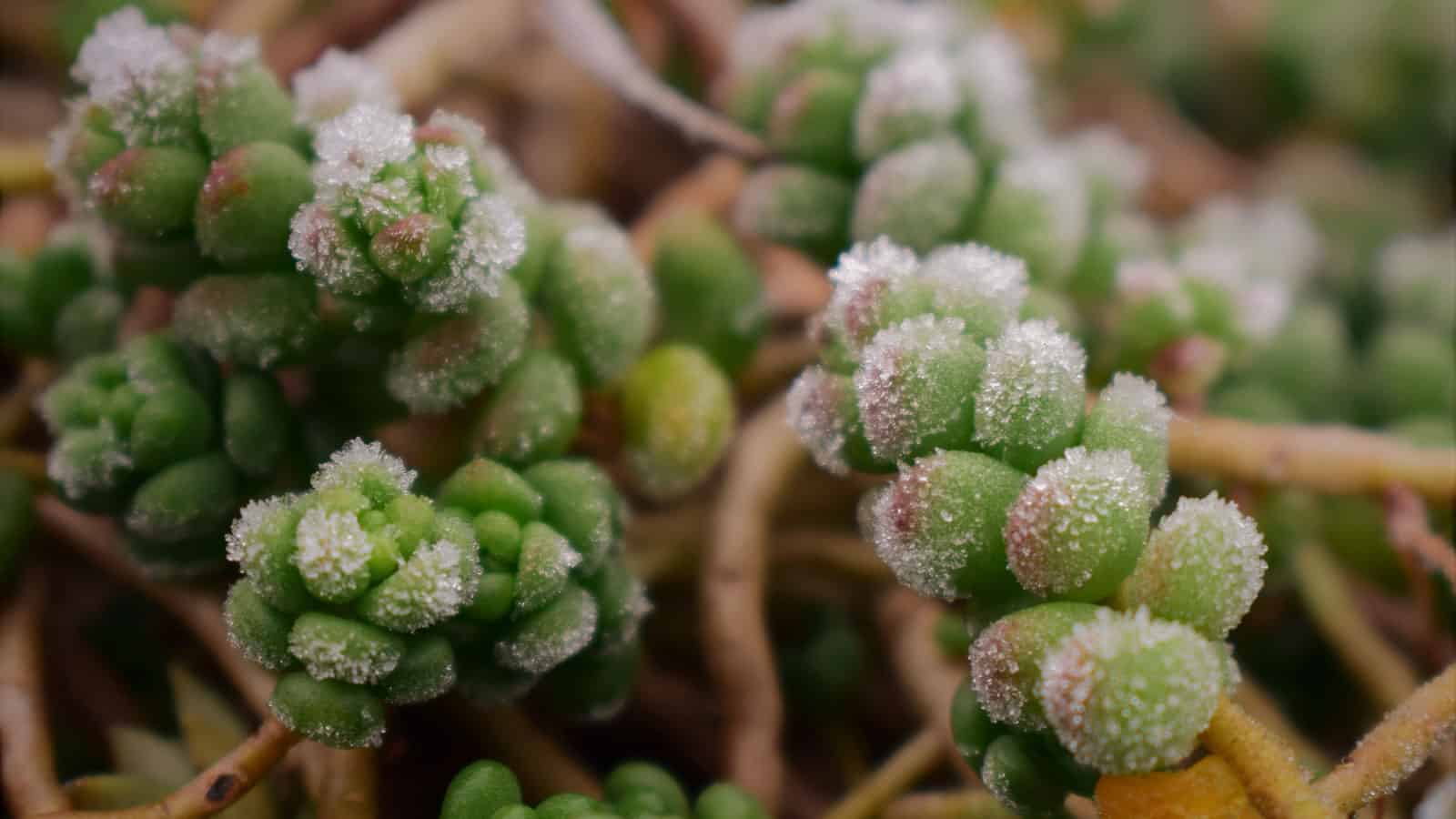Think succulents are invincible? Think again!
While these trendy plants bring style and character to any garden, there's a hidden challenge they face: frost.

These hardy succulents are actually quite sensitive to cold snaps. An unexpected frost can turn your thriving succulent haven into a disaster zone.
But don’t worry! We'll share with you information on how you can shield them from chilly surprises.
Let's make sure your green beauties are frost-ready!
How Succulents Are Affected by Frost
Succulents are specialized plants with thick, fleshy leaves that retain water, adapting them to arid environments.

However, exposure to cold weather, and especially frost, can pose significant challenges to these hardy plants.
When temperatures drop enough to cause frost, it can freeze the water inside the plant cells, leading to cell damage or even cell death.
The water expands when frozen, rupturing the cell walls, and thus can compromise the plant's vitality or survival.
The Visible Signs of Frost Damage
Frost damage in succulents is not always immediately apparent. Initially, the affected areas may appear soggy or soft as the plant thaws.
Over time, these areas might turn brown or black, indicating severe damage or necrosis.
In some cases, the leaves may droop, wilt, or fall off the plant. It's important to regularly inspect your succulents for these signs, especially after a cold night.
Preparation for Frost
Protecting your outdoor succulents from frost requires a proactive approach. Here's what you can do:
Long-Term Acclimatization
To get your succulents ready for frost, start by gradually exposing them to cooler temperatures.
Begin this process in the early fall so that they can adjust to the temperature drop slowly:
Begin to reduce the frequency of watering to mimic the natural dry season, encouraging a dormant state.
Move your succulents to a sheltered spot that still receives ample sunlight but is protected from harsh winds.
This long-term acclimatization helps in strengthening your succulents, making them more resistant to the shock of the first frost.
Immediate Pre-Frost Measures
When a frost warning is announced, you need to act immediately to shield your plants:
1. Cover Your Succulents
Use frost cloths or burlap to cover your plants in the evening. Make sure the material is lightweight to avoid damaging the succulents beneath.
Remove the coverings in the morning once the temperature rises to allow for sunlight and air circulation.
2. Move Portable Succulents Indoors
For potted succulents, bring them inside your home or place them in a greenhouse where it's warm and the temperature is consistent.
Protective Measures During Frost
Here are some suggested ways to shield your plants from cold when temperatures drop:
Physical Barriers and Covers
To safeguard your succulents during frost, use physical barriers such as:
1. Sheets, Blankets, or Towels
These can be draped over plants to retain ground heat and minimize frost damage.
Make sure to use supports like stakes or wire loops to prevent the material from directly touching the foliage.
2. Frost fabric or row cover material
These are specifically designed to protect plants from cold while allowing light and moisture to reach them. They can be more effective than household fabrics.
Remember to remove the coverings during the day to allow for air circulation and sunlight.
Here are seven more protective measures to try: 7 Simple Hacks for Protecting Your Garden From Early Frost
Utilizing Microclimates
Creating and utilizing microclimates can significantly enhance frost protection.
First, you can place plants near walls or structures as these retain heat, creating a warmer environment.
You can also try elevating plants to help avoid cold air that settles near the ground, reducing the risk of frost damage.
Design your garden to take advantage of natural shelters and warm spots.
For instance, placing succulents beneath a large tree can sometimes provide enough protection from brief frost.
Post-Frost Recovery
After your outdoor succulents have been exposed to frost, it's crucial to assess the damage and take appropriate steps to nurture them back to health.
Assessing Damage
First, you need to carefully inspect your succulents for signs of frost damage.
Look for darkened, soft, or mushy leaves, which are indicators that the plant's tissues have been affected.
It's best to do this when the plant is dry to avoid causing more damage.
Nursing Damaged Succulents Back to Health
Once you've identified the damaged areas, use clean, sharp scissors to trim away any blackened or mushy tissues to prevent potential rot from spreading.
Allow the cuts to heal after pruning and let the wounds dry and callous over, which may take a few days.
Also, reduce watering to minimize the risk of rot in the weakened plant.
Here's how to save your succulent from rot: 4 Steps to Save Your Succulents from Rot
Choosing the Right Succulents for Your Climate
Selecting succulents that can survive a drop in temperature is vital if you live in an area susceptible to frost. Some succulent species are more frost-tolerant than others.
For example, Sempervivum (Hens and Chicks) and Sedum are known for their resilience in colder climates.
Remember to look for species that can tolerate temperatures at least a few degrees below your zone's minimum to provide a buffer for unexpected cold snaps.
Here's where you can check your zone: 2023 USDA Plant Hardiness Zone Map
Cultivation Practices to Enhance Frost Resistance
Specific soil amendments and watering techniques can greatly increase your succulents' ability to withstand chilly temperatures.
Soil Considerations
A well-draining soil mixture prevents water from pooling around the roots, which reduces the risk of frost damage and root rot.
Mix materials like coarse sand, perlite, or pumice into your soil to improve its drainage capabilities.
Watering Techniques Before Frosts
Water deeply a few days before the expected frost to help your succulents stay hydrated, which can enhance their frost resistance.
However, avoid watering immediately before a frost, as this can lead to frozen moisture around the roots, exacerbating potential damage.
Here are 5 Essential Tips to Avoid Overwatering Your Succulents.
Embracing the Challenge and Protecting Your Succulents
While frost presents a significant threat to our beloved succulents, it also teaches us the importance of understanding and adapting to our environment.
By being attentive to the needs of these unique plants and taking proactive measures against the cold, we can ensure they continue to thrive and beautify our gardens, even through the chillier months.
Remember, you're not just safeguarding your succulents—you're growing as a gardener too!
Happy gardening!

